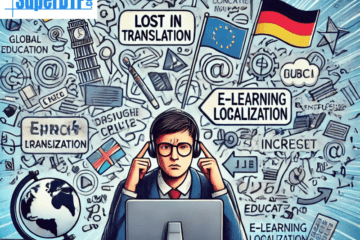E-learning has become a common method for learning and acquiring new abilities as a result of how technologically connected the world is becoming. Students can learn through e-learning at their own speed from any location in the world. However, it’s critical to recognise the significance of localising e-learning content if you want to reach a global audience. In this essay, I’ll go through the value of localising e-learning materials, advice for effective online learning, how to recognise cultural variations in e-learning, methods for doing so, and tools for doing so.
Introduction to E-Learning and Localization
People now frequently use e-learning to pick up new skills and advance their careers. Anyone can now access top-notch educational resources from anywhere in the world thanks to the growth of the internet. However, it’s critical to recognise the significance of localising e-learning content if you want to reach a global audience.
Content adaptation for a particular audience’s demands is known as localization. This may entail customising the content to local cultural norms, translating it into several languages, and making sure that users of various capacities may access it. You may improve learning outcomes and raise the effect of your content by localising e-learning materials to make them more interesting and pertinent to your audience.
The Importance of Localizing E-Learning Content
Localising e-learning content is crucial for a number of reasons. First of all, it can aid in enhancing educational outcomes. It can be more engaging and pertinent when content is modified to meet the demands of a certain audience, which can aid students in learning more efficiently. Localising your content can also help you establish credibility and trust with your audience. You may demonstrate that you comprehend and respect your audience by tailoring your material to fit local cultural standards. This can lead to the development of better relationships.
Additionally, localising your e-learning materials might boost their impact. You may reach a larger audience and have a bigger impact on society if you make it more readily available to individuals throughout the world. This is particularly crucial in the globalised world we live in today when many of the problems we encounter are complicated and call for a team effort to address.
Tips for Successful Online Learning
Online learning can be difficult, especially if you’ve never done it before. However, there are a number of suggestions that can aid in your achievement. First and foremost, it’s crucial to select a workspace that is free from interruptions. You can stay on task and prevent procrastination by doing this. Setting specific objectives and creating a reliable study routine is also essential. You can do this to keep yourself motivated and make sure you’re moving forward.
Active participation in your course is a key strategy for success in online learning. This may entail talking with your teacher and fellow students, asking them questions, and participating in conversations. You can increase your comprehension of the subject matter and enhance your learning outcomes by actively participating.
Understanding Cultural Differences in E-Learning
When localizing e-learning content, it’s important to understand the cultural differences that exist between different regions of the world. This can include differences in language, cultural norms, and educational practices. For example, some cultures may value group works more highly than individual work, while others may have a preference for visual learning aids.
To ensure that your e-learning content is effective, it’s important to take these cultural differences into account. This can involve adapting your content to suit local cultural norms, using appropriate language and visual aids, and ensuring that your content is accessible to people with different abilities.
Strategies for Localizing E-Learning Content
There are several strategies that you can use to localize your e-learning content effectively. Firstly, it’s important to identify your target audience and their specific needs. This can involve conducting research into local cultural norms, language preferences, and educational practices.
Once you have identified your target audience, you can begin to adapt your content to meet their needs. This can involve translating your content into different languages, using appropriate visual aids, and adapting your course structure to suit local educational practices. Additionally, it’s important to ensure that your content is accessible to people with different abilities, such as those with visual or hearing impairments.
Tools for Localizing E-Learning Content
There are several tools that you can use to localize your e-learning content effectively. These can include translation software, visual aids, and accessibility tools. Translation software can help you to translate your content into different languages quickly and accurately, while visual aids can help to make your content more engaging and relevant to your audience. Accessibility tools, such as screen readers and closed captioning, can help to ensure that your content is accessible to people with different abilities.
Conclusion
In conclusion, localizing e-learning content is essential for reaching a global audience and maximizing your impact. By adapting your content to suit local cultural norms and educational practices, you can improve learning outcomes and build stronger relationships with your audience. Additionally, by using appropriate tools and strategies, you can ensure that your content is accessible to people with different abilities. By following the tips and strategies outlined in this article, you can successfully localize your e-learning content and make a positive impact on society.


